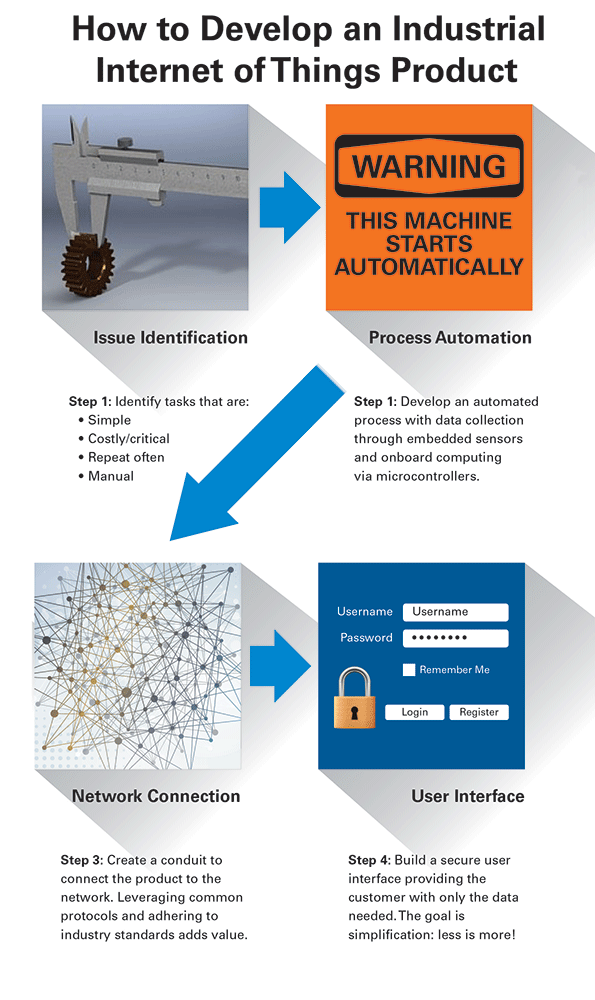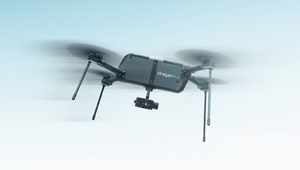Product-Development Strategies in the IIoTProduct-Development Strategies in the IIoT
Designers should consider these tips and techniques when incorporating the Industrial Internet of Things into their product-development strategy.
June 21, 2016

By Steven Fales
Imagine a production machine that anticipates its own maintenance needs—and orders the parts to fix itself—or a piece of manufacturing equipment that can manage its own energy consumption. This is just the tip of the iceberg in terms of the exciting opportunities promised by Industrial Internet of Things (IIoT) technology. IIoT is a disruptive force that will shape product-development trends over the next decade and beyond.
What is the Internet of Things? Fittingly, Wikipedia provides one of the clearest definitions: “The network of physical objects—devices, vehicles, buildings, and other items embedded with electronics, software, sensors, and network connectivity—that enables these objects to collect and exchange data. It allows objects to be sensed and controlled remotely across existing network infrastructure, creating opportunities for more direct integration of the physical world into computer-based systems, and resulting in improved efficiency, accuracy, and economic benefit.”
When it comes to IIoT market adoption, it’s clear we are in the early stages of understanding and acceptance In a recent survey, 13% of industrial engineers said they are moving forward with IIoT technologies today, and an additional 22% are considering pilot projects. By 2025, analysts estimate that robots will perform 25% of all manufacturing and IIoT will connect 50 billion devices.
For today’s industrial product designers, IIoT will be much more than a buzzword. It will hold the potential for every plant floor component to be easily and cost effectively connected to the network. This capability will enable dramatic steps in improving product performance and reducing cost of ownership—factors that will have a major impact on a product’s market value and profit margin.

This pie chart describes the current rate of IoT adoption.
The Five Key Design Opportunities
As industrial machine and component designers begin product development, five logical areas emerge for IIoT integration. Are these opportunities a part of your product strategy?
Remote Monitoring and Access
Today’s industrial machines produce large quantities of diagnostic information. But retrieving this data in a meaningful way can be challenging. Frequently, prohibitive amounts of commissioning and integration are required to connect devices and access their usable information.
The combination of web-based technologies, networking, and software is permitting cost-effective remote access to machine data down to the device level. IIoT will allow designers to provide the maintenance technician, control engineer, and plant manager with easy access to diagnostic information whether at the plant, office, or home.
Analytics and Optimization
Plant operations must know the optimal time to perform machine maintenance to eliminate downtime. Maintenance personnel can identify variances in performance that signal problems. By analyzing specific performance trends, they can determine if a machine part is exceeding a limit or bound and thus requires servicing.
With the rapidly declining cost of sensors and wireless networking, production-equipment designers can make predictive maintenance, historical and live diagnostics, and tuning control available through a variety of software platforms. With this capability, the machine can send an alert to a person or system that a maintenance action must be taken.
IIoT enables designers to leverage the data available today to deliver cost-effective machine analytics and optimization that dramatically reduce production downtime and better utilize limited maintenance resources. Commissioning and troubleshooting are costly, so critical tasks are made easier via effortless access to comprehensive, automated diagnostic web pages that are simple and intuitive. With this technology, users can easily initiate a self-test, see real-time network/error information, and log various diagnostic events, including low- and high-voltage alarms.

Web-based diagnostic tools provide instant and remote access to troubleshoot problems.
Energy Consumption
Thanks to large reductions in the cost of sensor, wireless, and microprocessor technologies, designers will be able to manage energy in production machines in ways that were not economically achievable in the past. Like the new thermostats that “learn,” a production machine can be programmed to learn its own operating practices and significantly reduce energy use.
By using optimization algorithms and usage audits, designers can leverage a machine’s diagnostic and control functions to manage power consumption. In addition, the ability to program logic and intelligence into a machine enables it to power itself up and down, or shut off completely if idle.
Improved Asset Reliability
On a production machine, a valve fires, a cylinder moves, and a bearing turns thousands of cycles per day. With IIoT sensors, it is economically feasible to monitor these moving parts. Armed with this information, it is possible to determine if the devices are functioning within normal tolerances, or if their performance is degrading to the point of failure. This capability is known as “prognostics.”
The use of prognostics cost-effectively fulfills the promise of predictive maintenance for much greater asset reliability. Now, designers can build in the capability to predict a machine’s performance and maintenance requirements. For example, the machine would tell you that there is an increasing probability of device failure in the near future based on measured performance degradation. You could design the equipment to alert the user when it is going to fail, and send an automated message to the manufacturer or distributor if a replacement part is required.
IIoT and prognostics dramatically change the asset management game and maintenance practices. Instead of spending labor and money on unneeded preventative maintenance, or waiting until a machine breaks and suffering lost production, the machine can send an “I need to be fixed” alert and, in the future, fix itself. There is no production disruption and maintenance is performed only when needed.
Legacy Equipment Retrofitting and Virtually Infinite Lifecycle Design
Many production machines have life expectancies that exceed 20 years. Their extended service lifecycles raise two important issues: What can designers do in a cost-effective manner to update legacy equipment with IIoT capabilities? And, how can designers develop machines with virtually infinite lifecycles that outlast the customer need?
Relatively low-cost sensor, software, and network technologies can be leveraged on existing equipment to add significant value. If an OEM manufacturer has a large installed base, it should consider the development of kits that would update machine functionality and extend their service lives. For example, the protocol in the programmable logic controller (PLC) of a computer-numerical-control (CNC) machine might be converted to enable connection to a factory Ethernet network. This will unlock the machine’s data and allow information aggregation on a plant-wide basis.
On the other hand, if creating a new product, the designer should incorporate IIoT technologies to maximize its lifecycle. That means providing the user with the flexibility to continuously upgrade the machine in a cost-effective manner. Hardware should be capable of future software upgrades, and network protocols and standards should enable plug-and-play operability.
Three Foundational Design Considerations
To implement IIoT capabilities successfully in their products, developers must incorporate three design considerations.
The first and foremost is security. Well-publicized financial and personal data theft pales in comparison to the damage that can be done by hijacking manufacturing, refinery, and power-plant control systems. As IIoT enables greater control of the real world, focus must increase on investment in multi-layered security. This issue must be overcome to realize IIoT benefits.
The second is interoperability and modularity—the idea that components and machines must work together and connect seamlessly. Devices should be modular and plug and play on a network without extensive commissioning and configuration. That means incorporating higher-level standards that enable machines to easily talk with each other.
Finally, real-time capability moves equipment users out of the past and into the future. This is the difference between driving by staring in the rearview mirror versus looking through the windshield to see what lies ahead. It provides users with the knowledge of what’s going on in their machines today, and more importantly, what will happen tomorrow. Imagine a piece of production equipment that says, “I’m starting to see delays in how a spool is shifting in a valve. In 90 days, it’s probably going to fail. So we need to order parts.” Such a capability is possible with IIoT technology.
Summary
IIoT technologies will open up a host of new capabilities to machine designers. They will add significant value and competitive advantage to their OEM products. But designers will have to anticipate how their machines fit into the new IIoT world. That will require the specification of robust hardware, ample processing power, and sufficient memory to fulfill the enhanced software requirements that lie ahead. In addition, machines must work with the latest standards to transport data to higher-level networks for asset-management applications.

With IIoT, end-user customers will benefit from simpler equipment commissioning at lower cost. Factory-wide asset management will become feasible and cost-effective. And the promise of predictive maintenance will be achieved as prognostics become a reality. More and more customers now embrace IIoT, and they’re paying the extra cost for products that incorporate its benefits.
This article was originally published in our sister publication Machine Design.
You May Also Like
.jpg?width=700&auto=webp&quality=80&disable=upscale)
.jpg?width=700&auto=webp&quality=80&disable=upscale)

.jpg?width=300&auto=webp&quality=80&disable=upscale)


